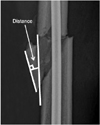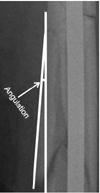Abstract
Purpose
For conservative treatment of shaft fractures, the butterfly fragments that were somewhat larger in the closed intra-medullary (IM) nailing. The results of treatment were monitored using radiography separately for the weight-bearing femur and non-weight-bearing humerus.
Materials and Methods
27 from Group I and 31 from Group II. In the two groups, the displacement and angulation changes in the fragments, and the degree of improvement of these two factors, were compared using follow-up radiography.
Results
The mean angulation of fragments in Groups I and II were 9.2° and 9.6°, and the mean degree of displacement of the fragments in Groups I and II were 16.7 mm and 21.2 mm, respectively. Follow-up radiography showed that the above factors improved in both groups. The degree of displacement was significantly lower in the normal cases than in the complicated cases (p=0.001).
Conclusion
Displacement and angulation gradually improved in both groups. It was found that the degree of displacement after the initial reduction is more important than the influence of anatomical position or weight bearing. This indicates that care should be taken when inserting IM nails to prevent displacement or angulation.
Figures and Tables
 | Fig. 1The degree of displacement of butterfly fragments were measured by longer pependicualr distance between shaft cortex parallel line and mid-point of fragment cortex parallel line. |
 | Fig. 2The degree of angulation of butterfly fragments were measured by angle between parallel line of shaft cortex and main fragment cortex on AP or Lateral radiograph. |
 | Fig. 3The fracture gap of main fragments were measured by distance between proximal and distal main fragment on AP or Lateral radiograph. |
 | Fig. 4
(A) Complicated case Lateral radiograph showing initial post-op finding with large amount of displacement.
(B) Complicated case Lateral radiograph showing no union evidence with remnanat displacement.
(C) Immediate post-operative Lateral radiograph showing bone graft status using mini-open procedure.
(D) Three months later follow-up Lateral raidograph showing radiologic union.
|
References
1. Böstman O, Varjonen L, Vainionpöö S, Majola A, Rokkanen P. Incidence of local complications after intramedullary nailing and after plate fixation of femoral shaft fractures. J Trauma. 1989. 29:639–645.

2. Bucholz RW, Heckman JD, Court-Brown C. Rockwood and Green's fractures in adults. 2006. 6th ed. Philadelphia: Lippincott-Williams & Wilkins Pb;1845–1914.
3. Choo SK, Kim BJ, Ko HS, et al. Studies on unreduced fragments in closed interlocking nailing of comminuted femoral fracture. J Korean Orthop Assoc. 1999. 34:579–586.

4. Christie J, Court-Brown C, Kinninmonth AW, Howie CR. Intramedullary locking nails in the management of femoral shaft fractures. J Bone Joint Surg Br. 1988. 70:206–210.

5. Claes LE, Heigele CA, Neidlinger-Wilke C, et al. Effects of mechanical factors on the fracture healing process. Clin Orthop Relat Res. 1998. 355 Suppl. S132–S147.

6. Farragos AF, Schemitsch EH, McKee MD. Complications of intramedullary nailing for fractures of the humeral shaft: a review. J Orthop Trauma. 1999. 13:258–267.

7. Globus RK, Bikle DD, Morey-Holton E. Effects of simulated weightlessness on bone mineral metabolism. Endocrinology. 1984. 114:2264–2270.

8. Habernek H, Orthner E. A locking nail for fractures of the humerus. J Bone Joint Surg Br. 1991. 73:651–653.

9. Holstein A, Lewis GM. Fractures of the humerus with radial-nerve paralysis. J Bone Joint Surg Am. 1963. 45:1382–1388.

10. Jeong HJ, Kim DY, Shin JH, Chu ET, Lim SR. A comparison of using interlocking IM nail versus plate fixation in humeral shaft fracture. J Korean Orthop Assoc. 1995. 30:709–716.

11. Johnson KD, Johnston DW, Parker B. Comminuted femoral-shaft fractures: treatment by roller traction, cerclage wires and an intramedullary nail, or an interlocking intramedullary nail. J Bone Joint Surg Am. 1984. 66:1222–1235.
12. Nam TS, Choi JW, Kim JH, Kim SY, Kim JJ, Chun JM. Nonunion of the humeral shaft. J Korean Fract Soc. 2005. 18:294–298.
13. Rothwell AG, Fitzpatrick CB. Closed Küntscher nailing of femoral shaft fractures. A series of 100 consecutive patients. J Bone Joint Surg Br. 1978. 60:504–509.
14. Sharma JC, Gupta SP, Mathur NC, et al. Comminuted femoral shaft fractures treated by closed intramedullary nailing and functional cast bracing. J Trauma. 1993. 34:786–791.





 PDF
PDF ePub
ePub Citation
Citation Print
Print





 XML Download
XML Download